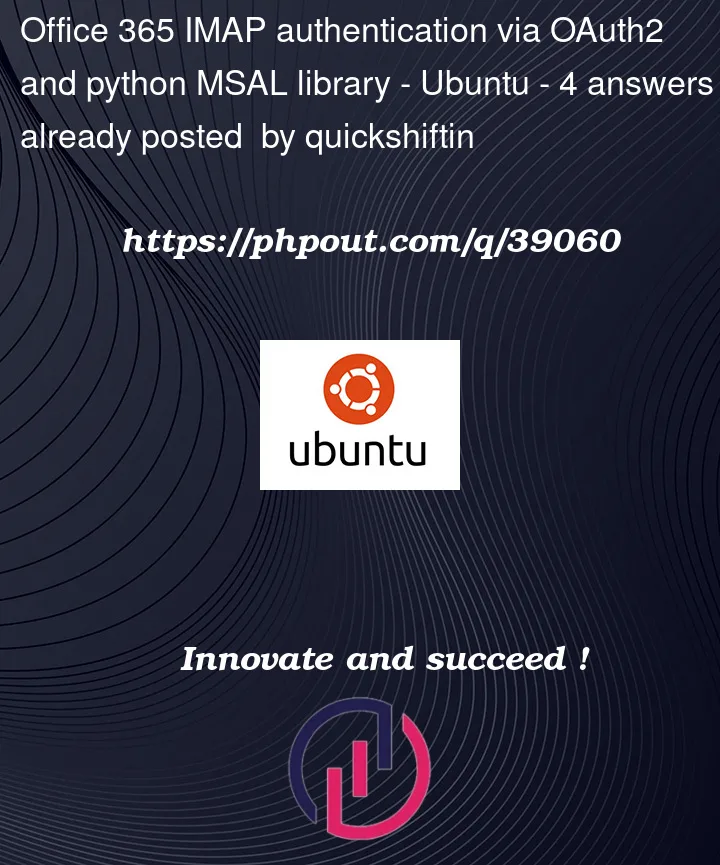I’m trying to upgrade a legacy mail bot to authenticate via Oauth2 instead of Basic authentication, as it’s now deprecated two days from now.
The document states applications can retain their original logic, while swapping out only the authentication bit
Application developers who have built apps that send, read, or
otherwise process email using these protocols will be able to keep the
same protocol, but need to implement secure, Modern authentication
experiences for their users. This functionality is built on top of
Microsoft Identity platform v2.0 and supports access to Microsoft 365
email accounts.
Note I’ve explicitly chosen the client credentials flow, because the documentation states
This type of grant is commonly used for server-to-server interactions
that must run in the background, without immediate interaction with a
user.
So I’ve got a python script that retrieves an Access Token using the MSAL python library. Now I’m trying to authenticate with the IMAP server, using that Access Token. There’s some existing threads out there showing how to connect to Google, I imagine my case is pretty close to this one, except I’m connecting to a Office 365 IMAP server. Here’s my script
import imaplib
import msal
import logging
app = msal.ConfidentialClientApplication(
'client-id',
authority='https://login.microsoftonline.com/tenant-id',
client_credential='secret-key'
)
result = app.acquire_token_for_client(scopes=['https://graph.microsoft.com/.default'])
def generate_auth_string(user, token):
return 'user=%s1auth=Bearer %s11' % (user, token)
# IMAP time!
mailserver = 'outlook.office365.com'
imapport = 993
M = imaplib.IMAP4_SSL(mailserver,imapport)
M.debug = 4
M.authenticate('XOAUTH2', lambda x: generate_auth_string('[email protected]', result['access_token']))
print(result)
The IMAP authentication is failing and despite setting M.debug = 4, the output isn’t very helpful
22:56.53 > b'DBDH1 AUTHENTICATE XOAUTH2'
22:56.53 < b'+ '
22:56.53 write literal size 2048
22:57.84 < b'DBDH1 NO AUTHENTICATE failed.'
22:57.84 NO response: b'AUTHENTICATE failed.'
Traceback (most recent call last):
File "/home/ubuntu/mini-oauth.py", line 21, in <module>
M.authenticate("XOAUTH2", lambda x: generate_auth_string('[email protected]', result['access_token']))
File "/usr/lib/python3.10/imaplib.py", line 444, in authenticate
raise self.error(dat[-1].decode('utf-8', 'replace'))
imaplib.IMAP4.error: AUTHENTICATE failed.
Any idea where I might be going wrong, or how to get more robust information from the IMAP server about why the authentication is failing?
Things I’ve looked at
-
Note this answer no longer works as the suggested scopes fail to generate an Access Token.
-
The client credentials flow seems to mandate the
https://graph.microsoft.com/.defaultgrant. I’m not sure if that includes the scope required for the IMAP resource
https://outlook.office.com/IMAP.AccessAsUser.All? -
Verified the code lifted from the Google thread produces the SASL XOAUTH2 string correctly, per example on the MS docs
import base64
user = '[email protected]'
token = 'EwBAAl3BAAUFFpUAo7J3Ve0bjLBWZWCclRC3EoAA'
xoauth = "user=%s1auth=Bearer %s11" % (user, token)
xoauth = xoauth.encode('ascii')
xoauth = base64.b64encode(xoauth)
xoauth = xoauth.decode('ascii')
xsanity = 'dXNlcj10ZXN0QGNvbnRvc28ub25taWNyb3NvZnQuY29tAWF1dGg9QmVhcmVyIEV3QkFBbDNCQUFVRkZwVUFvN0ozVmUwYmpMQldaV0NjbFJDM0VvQUEBAQ=='
print(xoauth == xsanity) # prints True
- This thread seems to suggest multiple tokens need to be fetched, one for graph, then another for the IMAP connection; could that be what I’m missing?




4
Answers
Try with this script:
Source: https://kontext.tech/article/795/python-send-email-via-microsoft-graph-api
Try the below steps.
For Client Credentials Flow you need to assign “Application permissions” in the app registration, instead of “Delegated permissions”.
Now you can generate the SALS authentication string by combining this access token and the mailbox username to authenticate with IMAP4.
#Python code
The
imaplib.IMAP4.error: AUTHENTICATE failedError occured because one point in the documentation is not that clear.When setting up the the Service Principal via Powershell you need to enter the App-ID and an Object-ID. Many people will think, it is the Object-ID you see on the overview page of the registered App, but its not!
At this point you need the Object-ID from "Azure Active Directory -> Enterprise Applications –> Your-App –> Object-ID"
Microsoft says:
Ofcourse you need to take care for the API-permissions and the other stuff, but this was for me the point.
So lets go trough it again, like it is explained on the documentation page.
Authenticate an IMAP, POP or SMTP connection using OAuth
Thats the code I use to test it:
After setting up the Service Principal and giving the App full access on the mailbox, wait 15 – 30 minutes for the changes to take effect and test it.
I wasn’t able to get any of the above solutions to work. It seems to me that Microsoft doesn’t really want you to interact with your office365 email account via IMAP anymore and instead wants you to use the Microsoft Graph Outlook REST API instead. The steps to set things up this way are simpler and I personally find the API easier to interact with than IMAP.
get_access_token()and the interact with your mail using requests… change the scope to be ‘https://graph.microsoft.com/.default’